To tell the story of Girl Scouts, we need to start with the Boy Scouts. The movements were founded by a British cavalry officer, Lieutenant General Robert S. S. Baden-Powell. He was known as the defender of the town of Mafeking in the South African or Boer War. He was made Lord in 1929. His idea was that boys 11 to 14/15 years old needed to be taught survival, self-reliance, and leadership, based on his 1903 book, Aids to Scouting. His movement of scouts was popular, and also among girls who, the legend says, signed up with their brothers. Thus, Lord Baden-Powell asked his sister Agnes to form the Girl Guides in 1910.
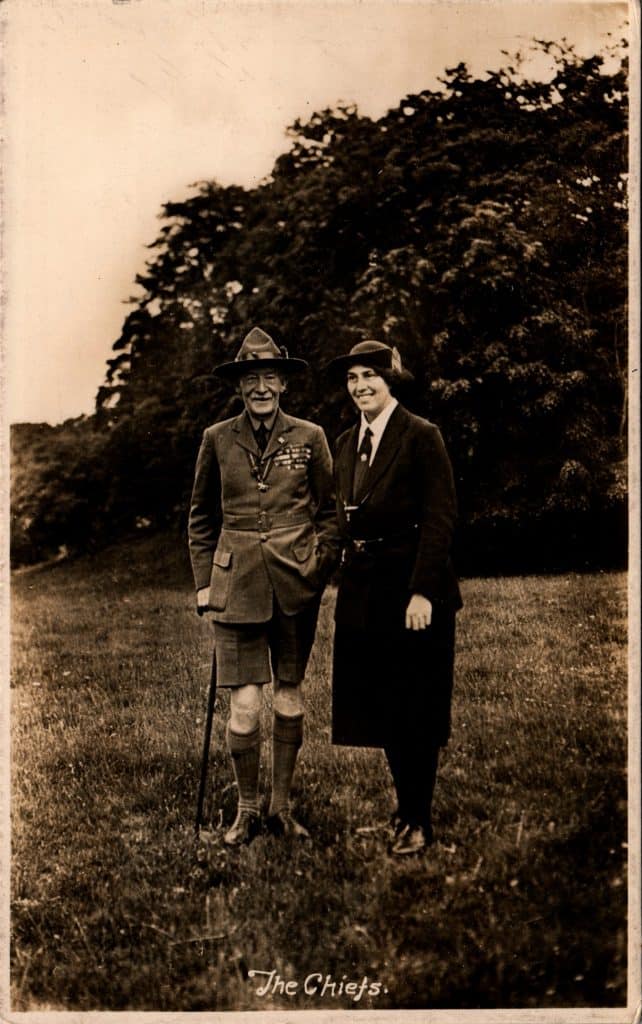
Baden-Powell married Olave St Clair Soames in 1912. She was 23 years old; he was 55. Olave became a newly invested Girl Guide in 1916 and lobbied to become the Chief – a move that eliminated Agnes.
Nevertheless, Agnes stayed involved in Girl Scouting for the rest of her life, even writing a book, How Girls Can Help to Build the Empire, a handbook for Guides.
Like Agnes, Olave also promoted scouts all over the world, until she was well into her 80s! Olave and Robert had the same birthday date – February 22.
Juliette Gordon Low nicknamed “Daisy,” was instrumental in creating the Girl Scouts in the USA.
Miss Gordon was born on October 31, 1860, in Savannah, Georgia. Her father was William Washington Gordon II, a cotton broker, who in 1861 joined the Confederate States Army to fight in the American Civil War. Her mother was Eleanor “Nellie” Lytle Kinzie, a writer whose family played a role in the founding of Chicago.

The Gordon family had six children; Daisy was the second born and named Juliette Magill Kinzie Gordon. Her childhood was adventuresome. Juliette had a number of illnesses and was accident prone, she sustained some injuries, including one accident that rendered her deaf in one ear. Her deafness caused Daisy to be aware of the needs of the disabled. She translated this into actions with her Girl Scouts movement.

During the civil war General William T. Sherman, friend of the family, visited frequently. He even arranged an escort to take her family to Chicago in March 1865 from Savannah to protect them from the war, while her father was fighting for the Confederacy. The father was reunited with the family when President Andrew Johnson issued the Amnesty Proclamation (1868), and they moved back to Savannah. Her family was quite wealthy as shown by her house.
Juliette Gordon married William Mackay Low on December 21, 1886, but it was not a happy marriage. Low died in 1905 just before she was about to request a divorce. Their arrangement was to live parttime in Savannah and in England.
While in England, she met Lord Baden-Powell and was enthusiastic about his ideas of scouting. She returned to Savannah to start the first Girl Guide troop in March 1912 with the words: “I’ve got something for the girls of Savannah, and all of America, and all the world, and we’re going to start it tonight!” She spent her fortune and the rest of her life promoting the movement.
Early on, her troop discussed the name of the movement and decided that it should be “Girl Scouts.” Girls were as daring as boys, and girls should not be guides only. Therefore, in 1915, she agreed, and it became Girl Scouts of USA. The scout movement always encourages boys and girls to be leaders, and this was an example, the girls deciding the name of the organization.
Since the Girl Scouts started in Savannah, Georgia, the first headquarters was in the remodeled carriage house of her home. However, she soon realized that if the organization was to be for the entire nation, she needed to be in Washington, DC.

The move came soon after when Mrs. Low signed a lease for room #502 in the Munsey Building at 1327 E Street, NW in Washington.

The monthly rent was $15, and she spent $2 for a sign on the door. It should be noted that the Munsey building was situated on E Street, N.W., between 13th and 14th Streets and it was designed by McKim, Mead & White of New York City. It was built in 1905 for the newspaper publisher, Frank A. Munsey, and 75 years later it was demolished to make room for a thirteen-story office building just four blocks from the White House.
Because the Boy Scouts had a headquarters site in New York, Juliette Low decided that her organization should also be there. Thus, she moved in 1916 to 189 Lexington Avenue, New York. Another move came in 1924, to 670 Lexington Avenue. After her death, the headquarters moved to 830 Third Avenue and again in 1992 to their present site at 420 Fifth Avenue. The best information available suggests that there is a postcard of the building at 670 Lexington Avenue where the office managed between 1924 and 1956, but an example has not been found.

The logo of Girl Scouts had many changes over the years but the first one was designed by Juliette Low herself! She received the U.S. design patent No. 45,234 on February 10, 1914, for the trefoil.
In 1921, Juliette Low transferred the rights to use the trefoil covered by her patent to Girl Scouts of USA, with the condition that Low, in perpetuity, was recognized in print and public statements as the organization’s founder. This agreement ensured her the immortality of her design and her memory.
In 1926, the first United States International World camp was held at Edith Macy Center, in Briarcliff Manor, New York. (Briarcliff Manor is a Hudson River Valley community 35 miles north of New York City.)
Juliette Low was present, but it was the last gathering she attended before her death in Savannah on January 17, 1927. She was 66.
At this event, February 22, was established as Thinking Day. The date was of course the birth date of both Chiefs, Lord Baden-Powell and his wife, Olave.
Thinking Day is still celebrated as a day full of activities with an international theme: learning about other countries.
The campsite was named after Edith Carpenter Macy, chair of the Girl Scout National Board of Directors from 1919 – 1925. When Mrs. Macy died, her husband, V. Everit Macy, an industrialist, philanthropist, and local government official donated the land and the capital needed as a memorial tribute to his wife. It is still in use today.
**
Girl Scouts of USA has published many postcards for the girls to send home from camp. In addition, many of the campsites around the country have created postcards.
Today the Girl Scouts organization is 2.5 million strong, with 50 million American women alive today who have participated in Girl Scouts while growing up. Including me!
Great story – always wondered why the U.S. version was called “girl scouts” instead of “guides”!
The first US troops were called Girl Guides. After less than a year, the girls told JGL that they wanted to be Girl SCOUTS. Boy Scout leaders freaked and threaten lawsuits. But JGL said that if her girls wanted to be scouts, they would henceforth be Girl Scouts. Lord Baden Powell backed her decision.
Some errors in early info and/or by the way it was written put a ‘spin’ on certain facts but still enjoyable.
Clarissa,
Thank you for sharing this article and the corresponding postcards. You are one of my favorite Deltiologist and we are privileged to have you as a leader in the Capitol Beltway Postcard Club. Marva
I hope that a future article might be in the works featuring Clarissa Ferraris’ collection of men at work with concrete. Some years ago, I developed an interest Rosendale cement but have since come to appreciate its off-shoot, mortar, so it’s interesting to read about related topics.
Agnes’s handbook was published in 1912, before Olave was involved, but otherwise you have the UK history correct. There is evidence that Juliet wasn’t the first person to bring the Guiding idea to the USA, but she did found the surviving organisation.
Thank you very interesting.